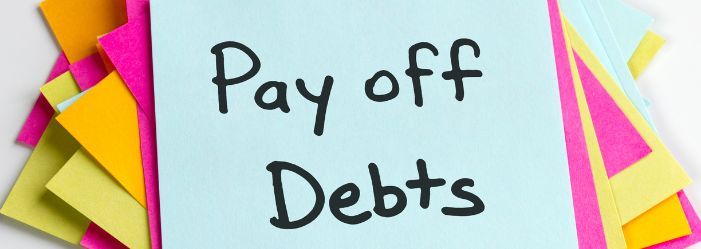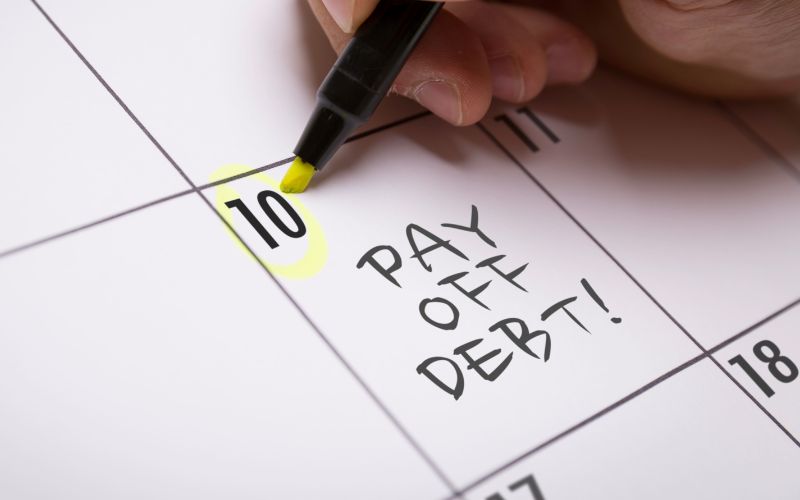Last Updated: March 26, 2024
The pros and cons to paying off your credit card in full each month

Disclaimer: We are not qualified legal or tax professionals and are not giving advice. Always speak with a qualified professional before making any legal or financial decisions.
In the complex world of credit management, the decision to pay off your credit card in full each month stands as a beacon of financial wisdom. Contrary to the myth that maintaining a balance benefits your credit score, the truth reveals a different narrative.
Paying your balance in full not only saves you from the high costs of compounded interest but also positions you as a responsible borrower in the eyes of lenders.
This guide dismantles common misconceptions and lays bare the undeniable benefits of zeroing out your balance monthly, from safeguarding your credit health to optimizing your credit utilization rate.
Let's learn the practices that not only preserve but enhance your financial stability in the long haul.
Immediate debt help available. Click here to speak with a debt specialist now for a free consultation.
Credit Scores
Credit scores are based on five factors that are collected on your credit report. Because we have quite a few blogs on credit history, we will take a brief look at these scores. If you'd like to read a more in-depth discussion, follow this link.
The five factors are payment history, debt-to-credit ratio, age of credit, credit mix, and new credit. How can paying off credit card debt affect these different factors?
Credit Card Interest Rates
The average credit card interest rate is currently around 18% APR. Carrying a balance and only making minimum payments can end up costing you a significant amount in interest charges over time. For example, if you have a $5,000 balance at 18% APR and you only pay the minimum payment each month, it will take over 17 years to pay off the balance and you will pay nearly $5,500 in interest charges alone. However, there are strategies, such as utilizing a zero percent APR balance transfer, to manage this. Learn more about this approach with our guide on zero percent APR balance transfer.
Payment History
Payment history is the most important factor in determining your credit score. As long as you pay your bills on time every month, this factor is not affected.
Paying your credit cards off each month helps your credit score because it improves your payment history. Missing multiple payments hurts your credit very quickly.
Debt to Credit Ratio
The debt-to-credit (DTC) ratio is the second most important factor. This compares the total amount of revolving or credit card debt compared to the total available credit limit you have available. This is also known as credit utilization.
For instance, if you have a revolving credit of $12,000 and revolving debt (account balances) of $6,000, you have a DTC ratio of 50%. If you decrease that revolving balance to $3,000 you now have a DTC of 25%. A DTC ratio should be less than 30%.
Paying off credit card debt improves your DTC ratio immensely and will help to improve your credit score. For a comprehensive approach to managing debts and steering towards financial freedom, explore our
tips on how to pay off debts.
Credit Utilization Ratio
Your credit utilization ratio is the amount of credit you are using compared to your total available credit. This ratio is generally expressed as a percentage. Your credit utilization ratio has a significant impact on your credit score. Lower ratios are better for your credit score. Experts recommend keeping your credit utilization below 30%.
Even if you pay off your credit card balance in full every month, your credit score can still be impacted by your statement balance, which is the balance reported to the credit bureaus. To maximize your credit score, consider paying down balances before your statement closing date each month. This will help keep your utilization low.
Age of Credit
Age look at how long you have had credit and how old each source is. If you close a credit card account after paying it, you do affect your score a bit.
However, since this only accounts for 15% of your score, the effect will be minimal.
Credit Mix
Credit Mix considers the different types of credit that you have. The reporting bureaus like to see personal loans, mortgages, revolving loans (credit cards), and other sources on your report.
Like age, paying off and closing your credit card can negatively affect your score. However, since the credit mix represents 10% of your score, this will not have a huge effect.
New Credit
When and how often you apply for new credit is another factor that affects your credit score. When you apply for new credit, such as a new credit card, loan, or financing, the lender will perform a hard inquiry on your credit report. Too many hard inquiries in a short period of time can lower your credit score.
When applying for new credit, consider the following guidelines:
- Only apply when you need access to additional credit
- Space out new applications by at least 6 months if possible
- Be cautious about applying for new credit if planning a major financing event soon, like a mortgage application
- Weigh whether you truly need a new account or if an existing account credit line increase may be better
- Compare costs of taking out a new loan versus transferring existing balances to a new card
Comparing Debt Payoff Methods
There are a few different strategies you can use to pay off credit card debt faster and reduce interest charges. The debt avalanche method involves paying off the card with the highest interest rate first while putting minimum payments toward the other debts. The debt snowball method prioritizes paying off the smallest balance first before moving to the larger debts.
Other options include balance transfer cards, which allow you to shift debt to a new card with a 0% intro APR for a limited time, and consolidation loans, which combine debts into one payment/loan with hopefully a lower interest rate. Each method has pros and cons to weigh.
Paid Off Credit Card Debt
As you can see, paying off your credit cards will have a small effect on your credit score. Understand how much your credit score increases after paying off credit cards. If you have been late making payments, your score will improve if you start paying bills on time.
Let's take a look at credit card interest and how that can hurt you.
Credit Card Interest rates
The average credit card rate of interest at the time of writing is 18.24%. Those high-interest debts are costing you a lot of money. You can find your interest rates on your credit card statements.
Let's see how carrying credit card debt versus paying in full affects you. These examples assume you have stopped using your credit card.
Monthly Payments
- Credit card balance: $6,000
- Current rate: 18.24%
- Payment: $120
- Time to debt-free: 95 months (almost 8 years)
- Interest paid: $5,352
- Total paid: $11,352
If you pay off your card in full, you save money - a lot of money!
Cost of Only Making Minimum Payments
Only making the minimum payment due on your credit cards will significantly increase the amount of time it takes to pay off your balance and how much you end up paying in interest. For example, if you have a $5,000 balance at 18% APR and your minimum payment is 3% of the balance ($150), it will take over 12 years to pay off the debt and you will pay about $5,500 in interest. If you can pay $250 per month instead, you can cut the payoff time in half to around 6 years and reduce the interest paid to about $2,800.
Double the Monthly Payments
If you can not afford to pay off your credit card bill in full, what happens if you make a double payment?
- Credit card balance: $6,000
- Current rate: 18.24%
- Doubled payment: $240
- Time to pay off: 32 months (almost 3 years)
- Pay interest: $1,605
- Total paid: $7,605
Ways to Pay Off Credit Card Debt
Most people do not have extra money just lying around to apply to the entire balance, especially if you have multiple debt sources. Here's a guide on how to pay off credit card debt on a tight budget and let's take a look at each different debt repayment method.
How These Debt Payoff Methods Compare

To compare how much the different payoff methods can save, let's look at an example. Say you have two credit cards - one with a $3,000 balance at 19% APR and one with a $5,000 balance at 16% APR.
If you used the debt avalanche method, focusing on the $5,000 card first, it would take around 5 years to pay off the balances and you'd pay $2,200 in interest. The debt snowball method would take around 5.5 years to pay off the debts and you'd pay $2,400 in interest.
A balance transfer card with a 0% intro APR could pay off the debt in 2 years with no interest but may have a 3% transfer fee. A consolidation loan at 10% APR could pay off the debt in 3 years with $1,400 in interest.
The Avalanche Method
The debt avalanche method is a payment strategy way to pay off multiple debts. In this method, you focus on paying off the smallest balance first. Once that is paid off, that payment is then added to the payment of the second smallest balance. You must be able to make more than the minimum payment on the lowest balance debt. You make minimum payments on the largest credit card balances.
The Snowball Method
In the debt snowball method, you focus on paying off the highest interest rate first. Once that one is paid off, you focus on the second-highest interest rate.
You may be able to request a lowered interest rate by calling the credit card issuer.
If you run numbers through a snowball and avalanche calculator, there is usually not a huge difference between the two methods in terms of which pays off debt faster and interest charges. The biggest difference is in your personality. If seeing immediate success inspires you, go with the avalanche method.
Balance transfer credit card
A balance transfer credit card is a way to consolidate debt. You may have gotten a lot of offers for balance transfer credit cards. These work by offering you 0% to very low-interest rates on balance transfers for a designated period of time. There are balance transfer cards with fees, based on your total transfer balances, although you may be able to find zero fees. Once the introductory period ends, the interest rate can be very high.
If you have a plan to pay off 100% of your balance transfer credit card within the promotional period, this may be a good option. You may not be able to transfer a very large credit card balance, but multiple balances of smaller cards may be an option. to transfer.
Debt consolidation loan
This is the second method to consolidate debt, A debt consolidation loan is an unsecured personal loan or a home equity loan that you take out to pay off the cards. You then focus on paying off the loan until you are debt-free.
This method works if you can qualify for a personal loan that has less interest than your bills. The monthly payments should be lower than what you currently have. You must also have a good credit score in order to be able to get the best loan terms.
Sometimes the best way to get a decent lower interest rate consolidation loan is to take out a home equity loan. If you fail to repay this loan, it will put your home in danger of foreclosure.
Debt Settlement
Debt settlement is usually conducted through a debt settlement company. In this method, you stop paying your unsecured bills while building up a savings account. The debt settlement company negotiates with each creditor and as the creditor settles, is paid off. The length of time depends on how much debt you have enrolled.
This method has two major drawbacks. The first is that it may damage your score. The second is that the IRS may view the settlement as income and you may end up with a substantial tax bill. For these reasons, debt settlement could be a final step before filing for bankruptcy. To better understand the nuances of debt and its implications, read about credit card debt forgiveness and its possibilities.
How do these Different Methods Compare?
Let's start with a two-credit card debt situation. This example assumes you STOP using your cards!
- Credit card 1: $6000 at 18.45%
- monthly payment: $120
- Credit card 2: $10,000 at 20%
- monthly payment: $200
- Avalanche Method
- Payoff $6000 first
- Minimum Payments: $150 +$200
- Time to pay off: 7 years
- Interest paid: $13,274
- Total paid: $29,874
- Snowball Method
- Pay off $10,000 first
- Minimum Payments: $230+$120
- Time to pay off: 7 years
- Interest paid: $13,557
- Total paid: $29,557
- Balance transfer card
- transfer $16,000
- transfer fee 3% (you may be able to find a 0% transfer fee)
- Total amount to pay off: $16,480
- Time to pay off: 12 months
- Minimum payment: $1,374
- Total paid: $16,480
- Debt Consolidation loan
- find loan for $16,000
- loan fee 0.5% (you may be able to find a 0%origination fee)
- Annual interest rate: 6%
- Total amount to pay off: $16,080
- Time to pay off: 5 years
- Payment: $311
- Total paid: $18,653
- Debt Settlement
- settle both debts for 30% - you owe $4800
- debt settlement fee of 15% per month
- monthly payment into a savings account: $555
- Time to pay off: 3 years
- Total paid: $19,968
What do all these numbers mean? Basically, if you can afford to pay $1,374 a month, the balance transfer card will save more money and eliminate your credit card balances the fastest. Debt consolidation is the second best choice to save money. If you can find a personal or secured loan with better terms, you can pay off your debt in five years.
Debt settlement looks attractive, but remember it is a last resort before bankruptcy because of the damage it does to your credit report and the tax debt. The avalanche and snowball take a long time and you pay full high interest and a lot of money over time.
Which is the best method to pay off credit card debt?
This depends on you and your financial situation. If you'd like to hear about all your options, give one of our certified debt professionals a call. They can help you understand your situation and what your best plan is.
We have worked with most credit card companies to settle $300 million in debt. Pacific Debt Relief specializes in debt settlement, but we recognize that this is not the best alternative for everyone. That is why we offer a free consultation and have trusted partners including counselors and debt consolidation companies that will work for you and your unique money situation.
Improving Your Credit Score
In addition to paying off credit cards each month, there are other tips that can help improve your credit score.
- Make all loan and bill payments on time each month
- Keep credit balances low/minimize credit utilization
- Have a mix of credit types (credit cards, auto loans, mortgages, etc)
- Limit new credit applications to only when needed
- Check your credit reports regularly and dispute any errors
FAQs
Conclusion
Managing credit card debt and improving your credit score may seem complicated, but taken step-by-step, it is very achievable. The key things to remember are: always try to pay your credit card balances in full each month; have a plan for paying off existing balances as fast as possible; limit new credit applications to only when needed; maintain positive credit behaviors like on-time payments; and monitor your credit reports regularly.
Putting these habits into practice will help you reduce your credit card debt, save on interest, and build an excellent credit score over time. The financial benefits of being a responsible credit card user are well worth the extra effort. With the right knowledge and discipline, you can take control of your debt and unlock better financing options for your future.
If you are struggling with overwhelming debt and want to explore your debt relief options, Pacific Debt Relief offers a
free consultation to assess your financial situation. Our debt specialists can provide objective guidance relevant information and support to help find the right debt relief solution.
*Disclaimer: Pacific Debt Relief explicitly states that it is not a credit repair organization, and its program does not aim to improve individuals' credit scores. The information provided here is intended solely for educational purposes, aiding consumers in making informed decisions regarding credit and debt matters. The content herein does not constitute legal or financial advice. Pacific Debt Relief strongly advises individuals to seek the counsel of qualified professionals before undertaking any legal or financial actions.
✔ Accredited by Better Business Bureau with BBB A+ rating (4.93 rating and 1678 reviews)
✔ US News and World Reports and Bankrate ranked Pacific Debt Relief as one of “The Best Debt Relief Companies of 2024”
✔ 6.9 star rating by BestCompany.com (over 2379 client reviews)
✔ 4.8 star rating by TrustPilot based (over 1613 verified consumer reviews)
✔ ConsumerAffairs.com Accredited (over 544 verified reviews with an average rating of 5 stars)
✔ A Top 10 Rated Compan by TopTenReviews.com , ConsumersAdvocate.com and Top10debtconsolidation.com
✔ 4.6 star rating by Google (229 client reviews)
✔ 100% rating by SuperMoney (9 client reviews)
Reduce Your Credit Card Debt By Up to Half

BBB Reviews | 4.9/5.0 Rating









 Do Not Sell My Personal Information
Do Not Sell My Personal Information